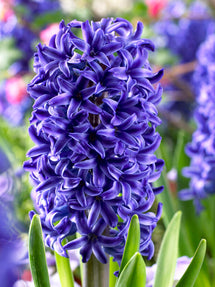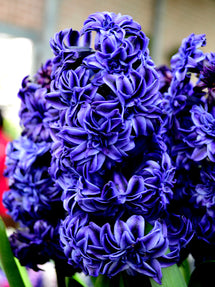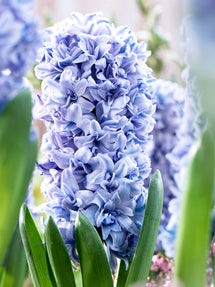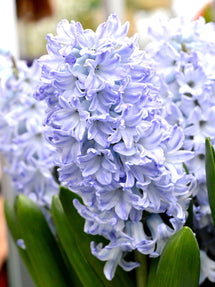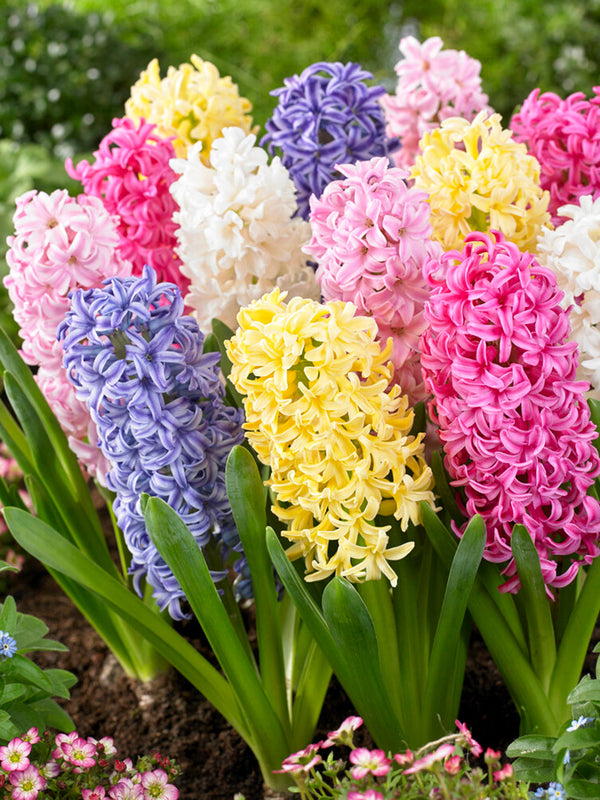Hyacinths
Hyacinths: The Stars Of Scented Gardens Bursting With Colour
Looking to brighten up your spring garden? The species (Common) Hyacinth is a timeless favourite, cherished for its vibrant hues and rich, sweet fragrance. With shades ranging from deep blue to soft pink and pure white, these striking blooms add charm to any flower bed, border, or container in the UK. Celebrated since the 17th century, Hyacinths remain a symbol of elegance and tradition. Experience their beauty for yourself and explore our finest Hyacinth bulb varieties to transform your outdoor space during early and mid-spring.
Showing 1 - 4 in 4 items
A Colourful Flower For The Perfect Springtime Display With Other Plants
Hyacinth plants make a superb addition to any spring garden. Their bold, compact flower spikes bloom in harmony with other spring-blooming bulbs, such as Daffodils, Grape Hyacinths, and early Tulips, bringing vibrant colour and depth to your outdoor display. When planted together, these springtime classics create a captivating blend of shapes, flower stalk heights, and hues, adding structure and balance to beds and borders. The rich fragrance of Hyacinths offers an extra layer of sensory pleasure, making your garden truly come to life.
Hyacinth bulbs can be planted more closely in pots, creating a fuller, more colourful display. They’re also perfectly suited to indoor arrangements in a bulb vase, bringing delightful fragrance and a touch of cheer to your home. Best of all, rabbits and squirrels tend to leave them well alone.
An Assortment Of The Finest Varieties In A Range Of Colours
Hyacinth plants are available in a stunning array of colours, from gentle pastels to rich, jewel-like tones, with varieties that differ in hue, form, and fragrance. Whether you’re designing a traditional spring border, filling patio containers, or creating a vibrant indoor display, our collection features some of the finest and most robust varieties on offer. Below is a selection of standout favourites from our range:
- Hyacinth ‘Blue Jacket’: The deep blue blooms of this variety are edged with the palest blue. They shimmer in the sunlight in a way only Hyacinths can.
- Hyacinth ‘Yellow Queen’: This variety produces magnificent, full flower spikes adorned with vibrant yellow blooms.
- Hyacinth ‘Woodstock’: A truly remarkable Hyacinth, featuring rich beetroot-purple blooms with petals that gently fade to maroon.
- Hyacinth ‘Carnegie’: This graceful, pure white variety produces spectacular flower spikes, each one bearing large, open florets that add a touch of refinement to any garden.
Can’t decide which variety to choose? Why not try our delightful Hyacinth mix, featuring at least six distinct colours? It’s the perfect choice for a rich and varied spring display – all with minimal effort.
How To Plant Hyacinth Bulbs For Maximum Impact In Your Garden
Hyacinth bulbs are cherished for their ability to create vibrant floral displays both outdoors and indoors. To achieve optimal results, correct timing and thoughtful placement are crucial. Plant the bulbs in autumn, before the ground begins to freeze. If you live in a warm climate, the soil may not become sufficiently cold to support proper root development. You might consider forcing the bulbs.
Wear gloves and start by selecting a sunny location with well-drained, rich soil, as Hyacinth plants dislike waterlogged conditions. There is no need to apply compost or mulch. When planting, dig each hole to a depth of approximately 15 cm. A useful guideline is to cover the bulb with soil to a depth around twice its height. Position each bulb with the pointed end facing upwards, spacing them roughly 8 cm apart. If planting in containers, place them slightly closer together. Once planted, water thoroughly to help settle the soil around the bulbs.
Once the blooms have faded, allow the plant to rest. The foliage will naturally die back, and there is little need for watering during this period. You may remove the withered Hyacinth leaves, or leave them to decompose naturally into the soil. Need further guidance? Refer to our growing guide, “How to Grow Hyacinths”, for more detailed information.
Top-Quality Hyacinth Bulbs For Sale At DutchGrown
Whether you're planting in containers or directly in the garden, DutchGrown offers top-sized Hyacinth bulbs specially selected for vigorous growth, vivid colour, and dependable performance. These premium bulbs will reward you with striking spring blooms that truly stand out. Browse our range of Hyacinth bulbs for sale and enhance your garden with some of the finest specimens available. We offer delivery across the United Kingdom.
Frequently Asked Questions About Hyacinths
Do Hyacinths Like Full Sun Or Shade?
Hyacinth plants thrive best in full sun or partial shade. For robust blooms and healthy growth, select a position that receives at least a few hours of direct sunlight each day. While they can tolerate some shade, insufficient light may lead to fewer and less vigorous flowers.
What Do You Do With Hyacinths After They Bloom?
After flowering, allow your Hyacinths to rest. The blooms will fade, and the foliage will gradually die back by late summer — a normal part of their life cycle. During this period, reduce watering and avoid disturbing the bulbs. You may remove the withered leaves for a neater appearance, or simply let them decompose naturally into the soil.
Do Hyacinths Come Back Every Year?
Hyacinths are generally perennials, and it is possible they return year after year if given the right care. To encourage reliable flowering, plant them in a sunny position with well-drained soil, and ensure the area remains relatively dry during the summer months. Excess moisture may lead to bulb rot. An ideal location is on the sunny side of a shrub or hedge, where nearby roots help absorb surplus water and offer natural protection for the bulbs.
Can You Leave Hyacinth Bulbs In The Ground All Year?
In colder regions, Hyacinth bulbs can remain in the ground throughout the year. They require a period of winter chilling to flower again successfully. However, in warmer climates, you’ll need to lift the bulbs after flowering, store them in the refrigerator for 6 to 8 weeks, and replant them in the autumn. This cold treatment is essential for encouraging strong, healthy blooms the following spring.
How Do I Care For A Hyacinth In A Pot?
Hyacinths require minimal watering during their flowering period—generally only every 3 to 5 days during dry spells. After flowering, allow the leaves to remain on the plant, as they nourish the bulb for the following year through the process of photosynthesis. Remove the foliage only when it has turned yellow. At this point, the plant will enter its dormant phase. Do not water it again until the following spring.
